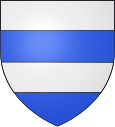Guingamp
|
Guingamp Gwengamp |
||
|---|---|---|

|
|
|
| region | Brittany | |
| Department | Cotes-d'Armor | |
| Arrondissement | Guingamp ( sub-prefecture ) | |
| Canton | Guingamp ( chief lieu ) | |
| Community association | Guingamp Paimpol Armor Argoat Agglomération | |
| Coordinates | 48 ° 34 ′ N , 3 ° 9 ′ W | |
| height | 62-126 m | |
| surface | 3.41 km 2 | |
| Residents | 6,895 (January 1, 2017) | |
| Population density | 2,022 inhabitants / km 2 | |
| Post Code | 22200 | |
| INSEE code | 22070 | |
| Website | http://www.ville-guingamp.fr/ | |
 City Hall ( Hôtel de ville ) Guingamp |
||
Guingamp [ ɡɛ̃ˈɡɑ̃ ] ( Breton Gwengamp ) is a commune in France in the Côtes-d'Armor department in Brittany , between Saint-Brieuc and Brest . It is the seat of the sub-prefecture of the arrondissement of the same name . Guingamp is located around 100 meters above sea level on the Trieux river in a wooded area and has 6,895 inhabitants (as of January 1, 2017).
history
In Gallo-Roman times, Guingamp was a station on a trade route between Normandy and northwestern Brittany. A fortress was built here in the 9th century, where in 1364 the Breton troops of Charles de Blois, under their leader Bertrand du Guesclin, gathered to go to the battle of Auray ( disputes over the claim to power to succeed Duke Jean III. on the verge of the Hundred Years War ). Guingamp later developed into a regional center for weaving .
Population development
| year | 1962 | 1968 | 1975 | 1982 | 1990 | 1999 | 2006 | 2016 |
| Residents | 8912 | 9232 | 9284 | 8507 | 7905 | 8008 | 7724 | 6899 |
| Sources: Cassini and INSEE | ||||||||
Sights and events
- Remains of the medieval fortification
- Town hall ( Hôtel de Ville ) from the 17th century, originally an Augustinian monastery
- Notre-Dame-de-Bon-Secours , a Gothic basilica with a statue of a Black Madonna, which is said to have been brought to France by the crusaders and which is an annual destination for pilgrims, Monument historique
- the annual traditional folklore dance event Festival de la danse bretonne de la Saint-Loup (mid-August)
- the stadium of the professional football club En Avant Guingamp ( Stade de Roudourou ), which has more than twice as many seats as Guingamp residents
- In the area: forests with the menhir of Keroter and the Stèles Gauloises du Boulbin. A few kilometers to the west is the highest mountain in northern Brittany ( Menez-Bré , 302 meters high) with the pilgrimage chapel of Saint-Hervé
See also: List of Monuments historiques in Guingamp
traffic
Guingamp station is on the Paris – Brest railway line and is served by regional and high-speed trains. Lines to Carhaix and Paimpol branch off here . The N 12 also runs through the city in an east-west direction .
Breton language
On July 8, 2008, the local government committed itself to promoting the Breton language as part of the Ya d'ar brezhoneg (“Yes to Breton”) action plan . In 2007, 15.2% of primary school students received bilingual education.
Sports
The football club En Avant de Guingamp played since 1995 (with two interruptions) in the top French division (Ligue 1, formerly Première Division). Since the 2019/20 season , Guingamp has been playing second class again.
Partnerships
Since May 9, 2011 there has been a town partnership with the town of Aue in the Ore Mountains . This is primarily intended to develop or deepen economic, socio-cultural, sporting and club activities.
The St.-Pius-Gymnasium in Coesfeld and the Deutschhaus-Gymnasium in Würzburg are partner schools of the Lycée Notre-Dame in Guingamp.
Personalities
- Joseph Guy Ropartz (1864–1955), composer
- Yoann Le Boulanger (* 1975), racing cyclist
- Laurianne Delabarre (* 1987), volleyball player
"Guingamp" was the pseudonym of the Breton writer Jean Conan (1765–1834).
literature
- Le Patrimoine des Communes des Côtes-d'Armor. Flohic Editions, Volume 1, Paris 1998, ISBN 2-84234-017-5 , pp. 390-413.
Web links
Individual evidence
- ^ Ofis ar Brezhoneg : Enseignement bilingue
- ↑ City homepage Aue with information on the city partnership with Guingamp , accessed on June 13, 2020

